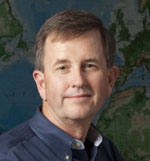Recent North Texas Earthquakes Not Unexpected
SMU seismologist Brian Stump says the recent earthquakes that have occurred near Dallas-Fort Worth and Cleburne are not unexpected, they illustrate the earth's natural dynamic nature.
From seismologist Brian Stump, the Albritton Professor of Geological Sciences in SMU's Dedman College :
 Prof. Brian Stump |
The recent earthquakes that have occurred near Dallas-Fort Worth and Cleburne are not unexpected: They illustrate the earth's natural dynamic nature. Rocks in the earth's crust store energy that is relieved when faults slip, and this motion generates the waves that are felt or recorded during an earthquake. In the stable part of the continental crust, such as the DFW area, the release of stored energy occasionally results in small earthquakes like those recently observed. It is not unusual for these events to occur in sequence over a short period of time.
Typically, we expect more than a million magnitude 2.0 earthquakes and 100,000 magnitude 3.0 global earthquakes in a single year. These recent North Texas events would cause little concern in seismically active areas like California, where energy stored in the Earth is much greater and constantly being released and regenerated along plate boundaries such as the San Andreas Fault.
In North Texas the sources of new strain energy are believed to be small and historical records suggest that local earthquakes are small to moderate in size.
Questions have been raised as to whether these very small earthquakes can be related to man-made activities, such as the extraction or injection of fluid into the crust that occurs in oil and gas production: Current information about these earthquakes cannot provide a definitive answer. Improved monitoring of earthquake locations and further characterization of the earthquake sequence may provide some insight into this issue. SMU scientists are installing 10 seismic monitoring stations (on loan from the Incorporated Research Institutions in Seismology and supported by the National Science Foundation) in the affected North Texas areas to help provide some answers.
It is important to remember that these events are very small, barely perceptible to humans, and that they are nearly 1,000 times smaller in energy (several magnitude levels) than earthquakes that are capable of causing significant property damage. The study of these events is motivated by scientific interest in how processes work in the Earth’s crust, how such earthquake sequences form and vanish, why such events are localized to a particular location, and how stress in the North Texas area builds and is released.
# # #